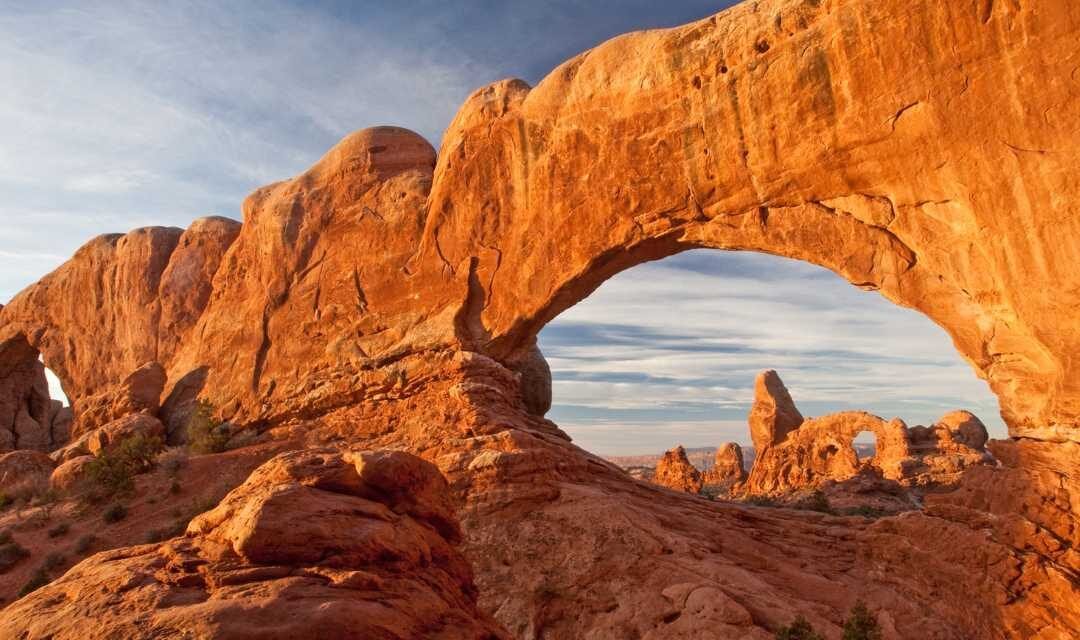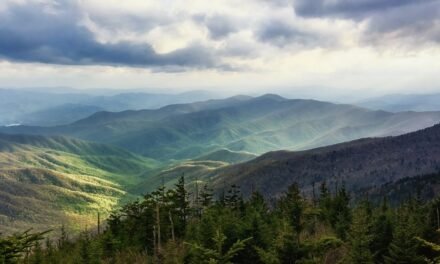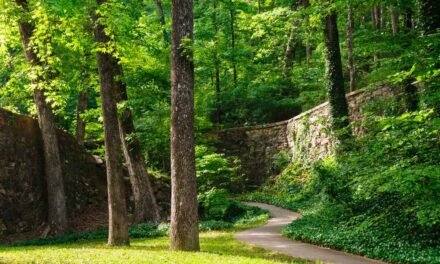Overview
Arches National Park, located in eastern Utah, is a stunning showcase of natural sandstone arches, unique rock formations, and breathtaking landscapes. The park is home to over 2,000 documented natural arches, making it the largest concentration of such formations in the world. With its striking red rock scenery and diverse recreational opportunities, Arches National Park is a must-visit destination for nature lovers and outdoor enthusiasts alike.
Arches National Park Location
Arches National Park is situated in eastern Utah, approximately 5 miles north of the town of Moab. The park is easily accessible via US Highway 191, which connects Moab to Interstate 70 to the north. The closest major city is Salt Lake City, about 230 miles to the northwest, while the nearest airport is Grand Junction Regional Airport in Colorado, approximately 110 miles to the east.
Arches National Park Things to Do
Arches National Park offers a wide range of activities for visitors, including hiking, scenic drives, photography, rock climbing, and stargazing. Some of the most popular activities and attractions in the park include:
Hiking
Arches National Park boasts over 50 miles of hiking trails, ranging from easy, family-friendly walks to more challenging, strenuous hikes. Some of the most popular trails include:
- Delicate Arch Trail: A moderately difficult 3-mile round trip hike that leads to the iconic Delicate Arch, the park’s most famous landmark.
- Devil’s Garden Trail: A 7.2-mile round trip hike that takes visitors through a diverse landscape of arches, fins, and spires, including the renowned Landscape Arch.
- Windows Trail: A short and easy 1-mile round trip hike that provides close-up views of the North and South Window Arches.
- Double O Arch Trail: A challenging 4.2-mile round trip hike that takes hikers past several unique arch formations, including the Double O Arch.
Scenic Drives
The 18-mile long Arches Scenic Drive offers visitors a chance to experience the park’s stunning scenery from the comfort of their vehicles. The drive begins at the park entrance and winds its way through various viewpoints, including Balanced Rock, The Windows Section, and Delicate Arch Viewpoint. Numerous pullouts and parking areas along the drive allow visitors to stop, take photos, and enjoy the breathtaking views.
Rock Climbing
Arches National Park provides ample opportunities for rock climbing and bouldering, with many popular climbing routes found within the park. Please note that climbing on any named arch or other fragile rock formations is strictly prohibited. Always adhere to the park’s climbing regulations and guidelines to ensure the preservation of the park’s unique features and your own safety.
Stargazing
With its remote location and limited light pollution, Arches National Park is an ideal destination for stargazing. The park’s clear desert skies offer exceptional views of the stars, planets, and the Milky Way. Ranger-led stargazing programs are often available during the summer months, providing visitors with a guided tour of the night sky.
Arches National Park Itineraries
Whether you have a few hours or several days to explore Arches National Park, there’s plenty to see and do. Here are suggested itineraries for different durations of stay:
Half-Day Visit
- Drive the Arches Scenic Drive, stopping at various viewpoints and trailheads along the way.
- Explore the Windows Section and hike the easy Windows Trail to see the North and South Window Arches.
- Visit Balanced Rock and take a short stroll around its base for a close-up view.
- Stop at the Delicate Arch Viewpoint and take a short walk to the Upper Delicate Arch Viewpoint for a distant view of the famous arch.
Full-Day Visit
- Begin your day with a hike to the iconic Delicate Arch, allowing 2-3 hours for the round trip.
- Drive the Arches Scenic Drive and explore the Windows Section, including the easy Windows and Double Arch Trails.
- Visit Balanced Rock and take a short stroll around its base.
- Spend the afternoon hiking the Devil’s Garden Trail, allowing 4-5 hours for the round trip. Be sure to see Landscape Arch and, if you’re up for the challenge, continue on to Double O Arch.
- Finish your day with a sunset view at the Delicate Arch Viewpoint or the Windows Section.
Multi-Day Visit
- Follow the full-day itinerary on your first day.
- On the second day, hike the Fiery Furnace, a ranger-guided 3-hour hike through a maze-like area of fins and sandstone formations. Advance reservations are required.
- Explore lesser-known areas of the park, such as Tower Arch or Broken Arch.
- Participate in a ranger-led program, such as a guided stargazing session, if available.
- Consider a day trip to nearby attractions, such as Canyonlands National Park or Dead Horse Point State Park.
Best Season to Visit Arches National Park
The best time to visit Arches National Park is during the spring (April-May) and fall (September-October) when temperatures are moderate and crowds are thinner. Summer months (June-August) can be extremely hot, with temperatures often exceeding 100°F (38°C), while winter (November-February) brings colder temperatures and occasional snowfall.
Arches National Park Weather
Arches National Park experiences a desert climate with hot summers, cold winters, and low precipitation throughout the year. Summer temperatures can exceed 100°F (38°C), while winter temperatures can drop below freezing. Spring and fall offer more moderate temperatures, with daytime highs ranging from 60°F to 80°F (16°C to 27°C). Rainfall is scarce, averaging around 9 inches (23 cm) annually, with the majority of precipitation occurring during the late summer monsoon season.
Arches National Park Hotels and Camping
While there are no hotels within the park, the nearby town of Moab offers a variety of accommodations, including hotels, motels, bed and breakfasts, and vacation rentals. Camping options within the park are limited to the Devils Garden Campground, which has 51 sites available on a reservation basis. Additional camping options can be found in the surrounding area, including at private campgrounds, Bureau of Land Management (BLM) campgrounds, and nearby state parks.
Arches National Park Restaurants
There are no restaurants within Arches National Park. Visitors are advised to bring their own food and water, as well as pack out all trash. The town of Moab, just a short drive from the park entrance, offers a variety of dining options, including restaurants, cafes, and grocery stores, catering to various tastes and budgets.
Arches National Park Wildlife and Plants
Despite the harsh desert environment, Arches National Park is home to a variety of wildlife and plant species. Commonly spotted animals include mule deer, desert cottontail rabbits, kangaroo rats, and various reptiles such as lizards and snakes. Birdwatchers can enjoy the sight of over 200 bird species, including canyon wrens, peregrine falcons, and golden eagles.
The park’s plant life is dominated by desert-adapted species, such as blackbrush, Mormon tea, and Indian ricegrass. During the spring, wildflowers like the globe mallow, paintbrush, and evening primrose add a touch of color to the landscape.
Arches National Park History
Arches National Park has a rich history, with evidence of human habitation dating back over 10,000 years. The park has been home to various Native American cultures, including the ancestral Puebloans, Fremont people, and the Ute and Paiute tribes. These groups left their mark on the landscape through petroglyphs, pictographs, and other archaeological sites found throughout the park.
In the late 19th and early 20th centuries, European-American settlers and ranchers moved into the area, drawn by the prospect of fertile land and natural resources. The park’s unique geological features and scenic beauty also attracted the attention of early conservationists, who advocated for its protection. In 1929, President Herbert Hoover signed the legislation that established Arches National Monument, which was later redesignated as a national park in 1971.
Throughout its history, Arches National Park has been a sacred and significant place for many Native American tribes. It is important to respect and honor their connection to the land, as well as recognize the historical injustices they have faced. Visitors should be mindful of their impact on the park’s cultural and natural resources, and strive to leave no trace during their visit.
Arches National Park Geology
The remarkable geological features of Arches National Park are the result of millions of years of erosion and deposition. The park’s iconic sandstone arches were formed through a series of geological processes, beginning with the deposition of sediments in an ancient sea. Over time, these sediments were buried, compacted, and cemented into layers of sandstone. As the Colorado Plateau uplifted, stresses in the rock led to the formation of cracks and joints. Water and wind erosion further sculpted the sandstone, creating the fins, towers, and arches seen today.
Conclusion
Arches National Park offers a unique and unforgettable experience for visitors, with its stunning red rock landscapes, captivating geological formations, and diverse recreational opportunities. Whether you’re hiking to the iconic Delicate Arch, exploring the Windows Section, or simply taking in the breathtaking scenery along the scenic drive, Arches National Park is a must-visit destination for nature lovers and outdoor enthusiasts alike. Remember to respect the park’s natural and cultural resources, and leave no trace to ensure that future generations can enjoy this remarkable place.





